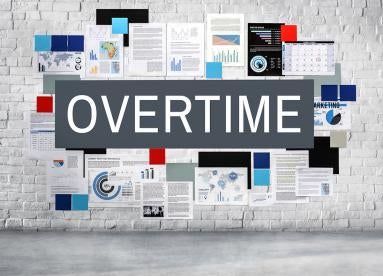On February 22, 2023, the U.S. Supreme Court issued a decision clarifying employers’ obligation to pay overtime under the federal Fair Labor Standards Act (FLSA). The decision, Helix Energy Solutions Grp., Inc. v. Hewitt, No. 21-984, — S.Ct. — (Feb. 22, 2023), affirmed the Fifth Circuit Court of Appeals’ interpretation of the FLSA’s overtime pay requirement, finding it applied even to very highly compensated employees unless one or more specific overtime exemptions applies.
The plaintiff, Michael Hewitt, sued his employer, Helix Energy Solutions Group, for overtime pay for work he performed on an offshore oil rig. Hewitt alleged that he typically worked 84 hours per week on the vessel but was paid a daily rate and no overtime pay. Hewitt earned more than $200,000 per year, which was calculated by multiplying his daily rate by the number of days he worked on the oil rig.
Helix responded that Hewitt was a bona fide executive employee and therefore exempt from the FLSA’s overtime requirements. Under the applicable regulations issued by the U.S. Department of Labor (DOL), an employee is considered a bona fide executive and exempt from the FLSA’s overtime protections if the following three tests are satisfied:
-
the employee is paid on a salary basis, meaning he receives a predetermined and fixed salary that does not vary based on the amount of time the employee works;
-
the employee receives a salary equal to or exceeding a specified amount (currently, $684/week); and
-
the employee performs job duties consistent with the exemption, namely supervision and direction of two or more full-time equivalent employees, authority to hire and fire employees, and management of an enterprise or department or division of an enterprise. 29 C.F.R. § 541.602(a).
The DOL relaxes the job duties provision of this standard when an employee is a highly compensated employee (HCE), meaning he earns at least $107,432/year. Although the HCE must still be paid on a salary basis and must earn at least $684/week, the HCE need only perform one of the exempt job duties to be treated as exempt.
The trial court agreed with Helix that Hewitt was a bona fide executive exempt employee, finding that Hewitt’s daily rate calculations resulted in biweekly wage payments that satisfied the salary basis test of the FLSA’s white collar exemptions. Hewitt appealed to the Fifth Circuit. Helix argued that Hewitt’s pay met the requirements of 29 C.F.R. § 541.602(a). Alternatively, Helix argued that Hewitt’s pay satisfied an exception to the salary basis test, 29 C.F.R. § 541.604(b), which provides that “[a]n exempt employee’s earnings may be computed on an hourly, a daily or a shift basis, without losing the exemption or violating the salary basis requirement, if the employment arrangement also includes a guarantee of at least the minimum weekly required amount paid on a salary basis regardless of the number of hours, days or shifts worked, and a reasonable relationship exists between the guaranteed amount and the amount actually earned.” The Fifth Circuit rejected both arguments, finding the record did not support a conclusion that Hewitt was guaranteed the minimum weekly required amount of pay or that he was paid on a salary basis.
Helix appealed to the U.S. Supreme Court but conceded that the Section 604(b) exception argument was inapplicable, making the sole issue on appeal whether a worker may be paid a daily rate and still satisfy the Section 602(a) salary basis test. The Court readily concluded that daily pay rates do not satisfy the FLSA’s requirements. The salary basis test requires payment of a fixed salary for any workweek in which the employee performs any work, without reduction for quality or quantity of work, whereas a daily rate presumes that a worker is paid only on days on which he works and thus that his wages are reduced by those days on which he performs no work. The Court also rejected Helix’s argument that Hewitt predictably was paid more than the salary threshold, finding that a salary implies “stability and security,” whereas Hewitt’s pay varied based on how many days he worked. Even though he was highly compensated, Hewitt did not receive a predetermined amount irrespective of days worked.
The Court also rejected Helix’s argument that Hewitt’s overall high compensation precluded an award of overtime, concluding that the HCE rule refers to the salary basis and salary level requirements in the same way that the general rule does. 29 C.F.R. § 541.601(b)(1). Although Helix urged the Court to consider the policy implications of imposing overtime pay requirements on employers that already generously compensate their workers, calling overtime in such circumstances a “windfall” for high earners, the Court refused to do so, nothing that “even the most formidable policy arguments cannot overcome a clear textual directive.”
The decision puts to rest questions about whether the DOL and courts can or should bend the rules when workers are highly paid but do not neatly fit within any of the exemption categories. The Supreme Court explained that Congress could have set a simple income level as the test for overtime exemption, but it did not do so. Nor did the DOL when adopting the HCE exception and relaxing, but not eliminating, the exempt duties requirement. In light of this decision, employers are urged to scrutinize their pay practices and satisfaction of exempt duties tests even with – perhaps especially with – their higher-earning employees, as the regular rate of pay and the overtime rate for such individuals is so substantial. Consider, by way of example, Hewitt’s entitlement to overtime. Hewitt alleges he worked 84 hours per week. He earned approximately $200,000 per year, which equates to $3,846/week. For the sake of simplicity, let’s assume that Hewitt worked the same number of hours and earned the same amount in wages each workweek. As a result, Hewitt’s regular rate of pay is $45.78 per hour. As a non-exempt employee, Hewitt would be entitled to an additional 0.5 times the regular rate of pay for each overtime hour he worked, for an additional $1,007.16 per week ($45.78 x 0.5 x 44 overtime hours). Applying the three-year statute of limitations for willful FLSA violations, Hewitt would be entitled to $157,117 in damages ($1,007.16 x 52 weeks x 3 years), plus an equal amount in liquidated damages, for a total of $314,234, before attorneys’ fees and costs. Factor in the other workers likely paid in the same way as Hewitt was and it is easy to see how quickly exposure can mount in the absence of careful FLSA compliance. Employers are encouraged to conduct periodic FLSA compliance audits with the assistance of counsel to avoid similar outcomes.




 i
i


